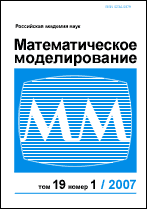|
Bifurcation model of the laminar-turbulent transition near a flat wall
O. V. Troshkin, S. A. Kozlov, S. V. Fortova, V. V. Shepelev, I. V. Eriklintsev
Institute for Computer Aided Design of RAS
Abstract:
In this article we describe a new mathematical model (bifurcational turbulence model) and argument why it's suitable for prediction of laminar and turbulent boundary layer characteristics. The model's distinguishing feature is that laminar-turbulent transition in medium arises as direct consequence of bifurcational properties of underlying RANS (Reynolds-averaged Navier–Stokes) equations which are closed in a specific way. The article is divided in three major parts. The first part describes RANS and second-order closure conditions along with premises that we use to obtain model equations in closed form. The second part is dedicated to the details of a particular turbulence model and its application to general shear layer problem. In the third part we consider turbulence transition in boundary layer over flat plate and present results of numerical simulations compared to experimental data for the case.
Keywords:
Navier–Stokes equations, RANS, laminar-turbulent transition.
Received: 12.02.2018
Revised: 12.02.2018
Accepted: 12.03.2018
Citation:
O. V. Troshkin, S. A. Kozlov, S. V. Fortova, V. V. Shepelev, I. V. Eriklintsev, “Bifurcation model of the laminar-turbulent transition near a flat wall”, Matem. Mod., 31:1 (2019), 114–126; Math. Models Comput. Simul., 11:5 (2019), 722–730
Linking options:
https://www.mathnet.ru/eng/mm4038 https://www.mathnet.ru/eng/mm/v31/i1/p114
|

| Statistics & downloads: |
| Abstract page: | 314 | | Full-text PDF : | 77 | | References: | 39 | | First page: | 15 |
|




 Contact us:
Contact us: Terms of Use
Terms of Use
 Registration to the website
Registration to the website Logotypes
Logotypes








 Citation in format
Citation in format 